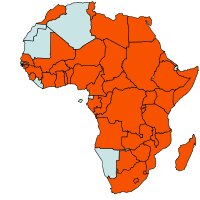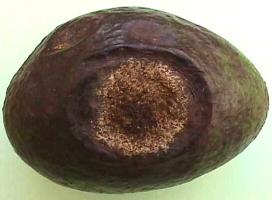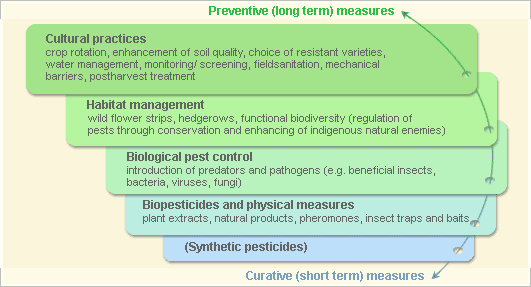
|
Anthracnose
Scientific name:
Colletotrichum spp. / Gloeosporium spp. / Glomerella spp. / Sphaceloma (Elsinoe) spp.
Type:
disease (fungal)
Common names:
anthracnose, brown blight (of coffee and tea), tear stain, dieback (citrus), fruit rot, stem canker, black spot of fruit, ripe rot of pepper, anthracnose tear-stain (mango)
Host plants: Avocados
Bananas
Beans
Cashew
Cassava
Citrus plants
Cotton
Cowpea
Cucumber
Eggplant
Green gram
Mango
Onion
Peas
Peppers
Pumpkin
Sorghum
Soybean
Spinach
Sugarcane
Tomato
Watermelon
Wheat
Yam
Zucchini/Courgette
|
| General Information on Disease and Damage | Cultural practices | |||
| Biology and Ecology of Anthracnose | Biopesticides and physical methods | |||
| Pest and disease Management | Information Source Links |
General Information on Disease and Damage
 |
| Geographical Distribution of Anthracnose in Africa (red marked) |
Introduction
Anthracnose are diseases of the foliage, stems, or fruits that typically appear as dark-coloured spots or sunken lesions with a slightly raised rim. Some cause twig or branch dieback. In fruit infections, anthracnose often has a prolonged latent stage. In some fruit crops, the spots are raised and have corky surfaces. Anthracnose diseases of fruit often result in fruit drop and fruit rot. Anthracnoses are caused by fungi that produce conidia within black fungal fruiting bodies called acervuli. Colletotrichum species are responsible for most anthracnose diseases. They are found in nature mostly in their conidial stage (asexual) and can overseason as mycelium (fungal threads) or conidia (spores) in foliage, stems, twigs and infected crop debris.Colletotrichum diseases are the most common anthracnoses and are very similar, if not identical, to the diseases caused by Glomerella. The latter is probably the sexual stage of most or all species of Colletotrichum (Gloeosporium). Anthracnose diseases, particularly those caused by Colletotrichum (Gloeosporium) or Glomerella fungi, are very common and destructive on numerous crops and ornamental plants. Although severe everywhere, anthracnose diseases cause their most significant losses in the tropics and subtropics. The diseases are favoured by wet, humid, warm conditions. They are spread by infected seed, rain splash and moist wind.
Damage
Anthracnose diseases, particularly those caused by Colletotrichum (Gloeosporium) or Glomerella fungi, are very common and destructive on numerous crop and ornamental plants. Although severe everywhere, anthracnose diseases cause their most significant losses in the tropics and subtropics. Pre- and post-harvest losses of many high-value crops are substantial in the tropics due to of various diseases caused by C. gloeosporioides. Flower infection on mangoes (blossom blight) can destroy flowers and young fruit and cause complete crop failure. Fruit infection may cause premature fruit drop, but major fruit losses occur during ripening when quiescent (dormant) infections break out and cause spreading black lesions. Anthracnose of other fruits also causes major post-harvest losses. Heavy infections cause rapid rotting, and even light infections which cause mainly cosmetic damage will shorten fruit storage life. Because of variability between seasons and locations, overall figures for losses are difficult to give, but it is clear that in many mango-growing areas losses of up to 50% of the crop to the various stages of the disease would not be uncommon.
Of the foliage diseases caused by C. gloeosporioides, yam anthracnose can be one of the most economically damaging and may prevent significant growth of tubers if the disease strikes early.
Anthracnose infected vegetables (e.g. beans, brinjals, peas, pepper and cucurbits) and fruits (e.g. avocado, mangoes and bananas) are not acceptable for export market.
Host range
C. gloeosporioides is a fungus which causes anthracnose, it is by far the most predominant a major Colletotrichum pathogen on a wide range of cultivated crops, particularly tropical perennial crops (Waller, 1992). However, because it is also a common saprophyte and secondary invader of damaged tissue, it has been implicated as a pathogen more often than is justified after closer investigation. Disease is favoured by wet/humid, warm conditions. It is spread by infected seed, rain splash and moist wind. Symptoms
 |
| Anthracnose (Colletotrichum gloeosporioides) on avocado fruit. This fungal disease is primarily a post-harvest problem when fruit is at maturity stage. |
| © A. A. Seif, icipe |
 |
| Anthracnose (Colletotrichum orbiculare) damage to pumpkin leaf (Cucumis sativus). |
| © Clemson University - USDA Cooperative Extension Slide Series, www.insectimages.org |
Flowering stage, fruiting stage, post-harvest, seedling stage, and vegetative growing stage.
Affected plant parts
Leaves, stems, fruits/pods, and inflorescence.
Biology and Ecology of Anthracnose
The lifecycle of anthracnose diseases involves essentially production of spores on susceptible hosts, dispersal of spores, penetration of host tissue, initiation of an infection process within the cells, development of lesions, formation of bristly spores and dispersal usually by water-splash, air currents, insects or other forms of contact.
The anthracnose pathogen reaches its most serious dimension at high moisture and warm temperature. For example C. gloeosporioides has an optimum of 25-29°C but it will also survive at temperatures as low as 4°C. Spore germination, dispersal and infection require relative humidities near 100%. However, in drier situations disease expression can occur when latent infections are activated through aging or tissue damage.
The anthracnose diseases are primarily transmitted through seed, but also through infected plant parts. Rain splash will also disperse spores within crop canopy. The pathogen persists on and in seed, crop residues, and weed hosts.
Major species of anthracnose fungi affecting crops in Africa:
- Anthracnose of avocado (Glomerella cingulata)
- Anthracnose of cotton (C. gossypii)
- Anthracnose of cucurbits (C. lagenarium)
- Anthracnose of grapes Sphaceloma (Elsinoe) ampelina
- Anthracnose of lime (Gloeosporium limitticola)
- Anthracnose of spinach (C. spinacicola)
- Anthracnose of tomato (C. coccodes, C. phomoides)
- Banana anthracnose (C. musae)
- Bean anthracnose (C. lindemuthianum (Glomeralla cingulata))
- Cereal anthracnose (C. graminicola)
- Coffee anthracnose (C. coffeanum)
- Common scab of citrus Sphaceloma (Elsinoe) fawcettii)
- Mango anthracnose (C. gloeosporioides)
- Onion smudge (C. circinans)
- Pea anthracnose (C. pisi)
- Pepper anthracnose (C. capsici)
- Red rot of sugarcane Glomerella tucumanensis (C. falcatum)
- Watermelon anthracnose (C. lagenarium)
Pest and disease Management
Pest and disease Management: General illustration of the concept of infonet-biovision

Further below you find concrete preventive and curative methods against Anthracnose.
Cultural practices
Field sanitation
1. Use certified disease-free seeds . Anthracnose is seed-borne. 2. Properly select healthy plants for transplanting.
3. Keep weeds under control at all times. Keep the surroundings of your farm free of weeds, unless they are maintained and intended as habitat for natural enemies.
4. Make yourself 'clean'. Always bear in mind that you might be the carrier of the diseases while you move from one plant to another
5. Pull out plants that are heavily infected.
6. Prune the plant parts of fruit trees that show severe symptoms of disease infection.
7. Properly dispose of all the infected plants.
8. Pick rotten fruits and collect those that have dropped and bury in a pit.
9. Plough-under the crop residues and organic mulches. This improves soil condition and helps to disrupt the disease lifecycle.
10. Maintain cleanliness on the irrigation canals.
11. If possible, remove all the crop residues after harvest. Add these to your compost pile.
12. Make your own compost. Your compost pile is where you can place your plant trimmings and other plant debris.
13. Clean your farm tools. Wash ploughs, harrows, shovels, trowels and pruning gears after use. Lightly oil pruning gears.
Hot water seed treatment
Pruning
- Makes the plant less dense
- Improves the air circulation and sunlight penetration that decrease the incidence of diseases and the conditions that promote fungal growth. It also allows better spray penetration and coverage
- Improves the appearance and health of plants
- Gets rid of the disease infected parts
- Allows the natural enemies to find their preys easily
- Controls the size of a plant
- Trains the young plants
- Influences flowering and fruiting (proper pruning of flower buds encourages early vegetative growth)
Reminders for crops that need pruning in their management
- Pruning is done best during dry weather as it minimizes the spread of the pathogens that cause diseases
- Always use sharp pruning tools to have clean and smooth cuts angled to shed water and to avoid direct sunlight
- Dip your pruning tools into container with 10% bleach solution and wash your hands and pruning tools between pruning the diseased plants
- After pruning, disinfect your pruning tools with 10% bleach solution
- Ask for assistance from your local agriculturist for the proper pruning techniques on fruit trees
Biopesticides and physical methods
Copper
In organic culture it is advised to consult your organic certification body. Also as copper products constitute propriety products, users are advised to comply with product label instructions on dosage, frequency of application, pre-harvest intervals and product safety (proper handling, storage, and disposal). Some examples of available copper products in the market include Kocide 101®, Kocide DF® and copper oxychloride.
When handling and/or applying pesticides observe the following:
- Read and follow the label instructions carefully.
- Ask for assistance from your local agriculture office when using copper for the first time.
- Monitor plants regularly and spray only when necessary as copper can accumulate in the soil.
- Do not smoke when handling/spraying
- Do not eat food when handling/spraying
- Spray in the early morning or late afternoon.
- Wear protective clothing when handling and/or applying any pesticide (including copper)
- Wash your hands after handling pesticides
Information Source Links
- CABI. (2004). Crop Protection Compendium, 2004 Edition. © CAB International Publishing. Wallingford, UK. www.cabi.org
- OISAT (Online Information Service for Non-Chemical Pest Management in the Tropics) www.oisat.org
- Waller, JM. (1992). Colletotrichum diseases of perennial and other cash crops. In: J.A.Bailey and M.J. Jeger (Editors). Colletotrichum: biology, pathology and control. CABI, Wallingford , ISBN 978-0851987569
- Wheeler, B.E.J. (1969). An Introduction to Plant Diseases. John Wiley & Sons Ltd. ISBN: 0 471 93752 5

 Back
Back
